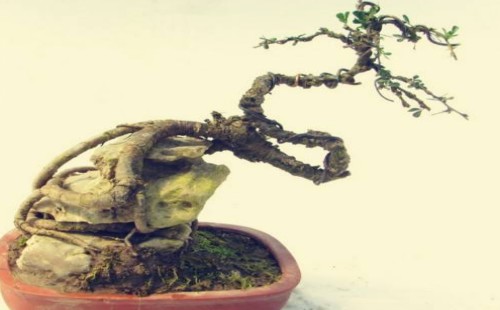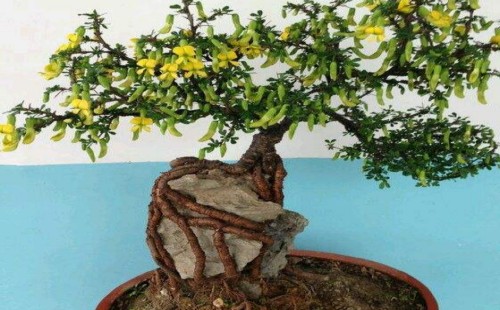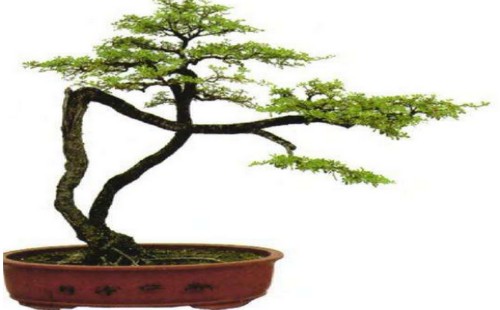How do canary bonsai take root?
Root is an important means to shape the root in the process of making open-root bonsai. First of all, the root should be properly treated in the process of potting, and the soil can not be covered according to the traditional method. When you put it on the basin, you can lift its root slightly and let it be exposed on the soil surface, which is not only easier to shape, but also reflects the potential of grasping the ground and the state of being old. But only this is not enough to reflect the root effect, more important is the technical processing of the root. So, how do canary bonsai take root?

The root of the canary bonsai is usually carried out during the upper pot transplanting, while the upper pot transplanting process is usually carried out when the plant enters the dormant period. The transplanted seedlings can be 2-3 years old seedlings or downhill stumps. If there is no suitable mountain stake, you might as well find a 2-3-year-old canary seedling to pot it. However, in order to facilitate the root modeling treatment, it is usually not allowed to carry soil at the root. After cleaning up the soil that clings to the roots, we need to comb the long roots of the canary and then arrange them so that they can be intertwined.
However, we can also use brown silk to tie it, so that it shows an intertwined state. As the roots of canaries, like branches, are often very soft and resilient, so as long as we can apply scientific practices in the process of root and processing, it is often a very elegant and interesting process. And if the root is done well, it can make the root look vigorous and majestic, which can bring a kind of feast for the eyes to the viewer. Because if the root is done well, not only the ornamental value is very high, but also the artistic effect and charm are very outstanding. Therefore, for the modeling treatment of canary bonsai, the root is an aspect that can not be ignored.
As for the modeling method of the bonsai root of the canary, it is generally taken to take root treatment, while after root treatment, there are often three forms of root treatment on the soil surface:
1. Sleeve type
Sleeve type is mainly used in the bonsai where it is difficult to sprout adventitious roots. The original tree trunk is pruned and shaped by this method to achieve the effect of root shape. Generally, the branches are girdled at a suitable height from the basin, and then sheathed with a section of plastic bottle. Of course, some culture soil needs to be loaded into the tube to ensure that the roots can sprout smoothly in the environmentally friendly place. During the cultivation, pay attention to keep the soil in the tube with appropriate humidity, and the sleeve can be removed after about 2-3 years, and the root system peeled out at this time is strong enough to make open-root bonsai.
Second, the barrier type
For the case that adventitious roots can sprout at the base of the trunk of the canary, we can usually achieve the treatment of exposing roots by building a high mound at the base. This method is generally carried out in the spring growth period, by artificially scratching at the base of the trunk to build a high mound to moisturize in order to sprout new roots. However, it still takes 2-3 years to complete this cultivation process, and finally achieve the goal of root modeling.
Third, the root type.
Tigen is a common technique and aspect in the process of bonsai modeling, so as to improve the artistic charm and ornamental value of bonsai. However, the root lifting process is generally completed in the process of potting or changing pots, and the root system should be scientifically chosen. Generally, it is necessary to keep the roots as strange as possible, so as to show the shape of the roots and double the value of bonsai.
Time: 2019-06-06 Click:
- Prev

The modeling of canary bonsai
The golden finch is also known as the golden finch because its flower shape is very similar to that of the bird spreading its wings and flying high. Broom is not only magical in shape, but also bright in color, so it has high ornamental value. As a result, the canary has become a rare bonsai tree species.
- Next

How to apply fertilizer to canary bonsai?
The canary is a kind of bonsai tree suitable for viewing flowers, which has the characteristics of light, drought and cold resistance, and it has strong germination ability and rapid growth, so we should pay attention to pruning in the process of daily maintenance and management to avoid new branches destroying the beauty of the original plant. But that's not enough.
Related
- Fuxing push coffee new agricultural production and marketing class: lack of small-scale processing plants
- Jujube rice field leisure farm deep ploughing Yilan for five years to create a space for organic food and play
- Nongyu Farm-A trial of organic papaya for brave women with advanced technology
- Four points for attention in the prevention and control of diseases and insect pests of edible fungi
- How to add nutrient solution to Edible Fungi
- Is there any good way to control edible fungus mites?
- Open Inoculation Technology of Edible Fungi
- Is there any clever way to use fertilizer for edible fungus in winter?
- What agents are used to kill the pathogens of edible fungi in the mushroom shed?
- Rapid drying of Edible Fungi

